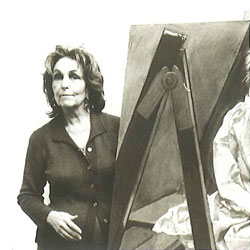Paula Rego
Paula RegoLisboa ¶ 1935
 |
|
| Créditos fotográficos / Photographic credits: Jane Brown/ Cortesia Malborough Fine Art, London |
She studied at St. Julian's college in Estoril, Portugal, and in 1952 she moved to London, fleeing away from the grey days of Salazar's regime. There, she entered the Slade School of Art and later on married painter Victor Willing. She would proceed to become one of the most respected artists in both the United Kingdom and Portugal. ¶ Paula Rego's works from the 50s are quite close to realistic codes, but a certain attention to odd details and its rough, crude gesture of painting are already visible and prized, as well as a certain virulent relationship with reality that protracts her choice for a fantasy universe, which sometimes seems to be a dreadful one. ¶ In the 60s her work achieves a stronger freedom and drive. The energy explosion provided by art brut meets a new mode of expression in collage, through which the artists tamed that very same energy in a more complex manner, given the fact it allows the intertwining of multiple effects, and more systematic as well, for it implies a selection that imposes its own specific rhythm. ¶ In the early 80s Paula Rego abandons collage and resumes her technique of drawing directly on the canvas, underpinning the freshness and the immediacy of her figures, and at the same time exercising a very peculiar mode of composition, in a carrousel-like deportment that make her paintings more and more lofty, but at the same time almost giddy. The main trait of this phase is the multiplication of characters and actions that fill up the canvas. ¶ In the middle of that decade, the author began another phase, in which the narrative became more rigorous, instead of the previous dispersion. Her new paintings, presenting a unity of time and space, not to mention a unity of action, became more dense, weighty, and more painting-like, discarding thus their prior more graphic nature. In the same way, they became more committed to the bodies' volume and the perspective of the surrounding spaces. ¶ Generally speaking, the central themes of Paula Rego's images are stories that only she knows entirely, but that are revealed to us at one particular, dramatic point, made clear by whatever the artist chooses, in any given example: the characters, the situation, or the whole scenography. ¶ Looking back on it in its entirety, we can look upon Rego's oeuvre as an obsessive exploration of the same theme: relationships as power relationships and power relationships as staged perversities.
View the embedded image gallery online at:
http://cvc.instituto-camoes.pt/biografias-en/paula-rego-46139.html#sigFreeId9790fecf55
http://cvc.instituto-camoes.pt/biografias-en/paula-rego-46139.html#sigFreeId9790fecf55


